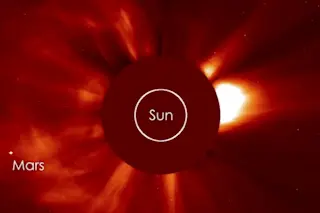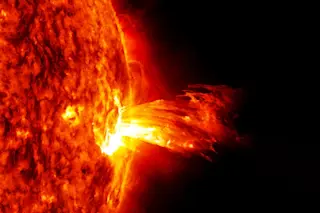Click on the image, captured by the Solar Heliospheric Observatory, to see an animation of a coronal mass ejection from the sun on the morning of April 11, 2013. (Image: Goddard Space Flight Center.) If recent posts here at ImaGeo are any indication, I must be obsessed with the sun. Just yesterday, I posted an incredible image of the solar surface. And here I am, at it once again. But I didn't tell the sun to let loose billions of tons solar particles into space today, in what scientists call a coronal mass ejection, or CME. (Update 4/12:
Now I'm at it again. See my post today about how the Earth protects itself from these gargantuan solar explosions.)
If you haven't done it already, click on the image above for an animation of images sent back to Earth by the Solar Heliospheric Observatory showing the CME exploding from the sun's ...














